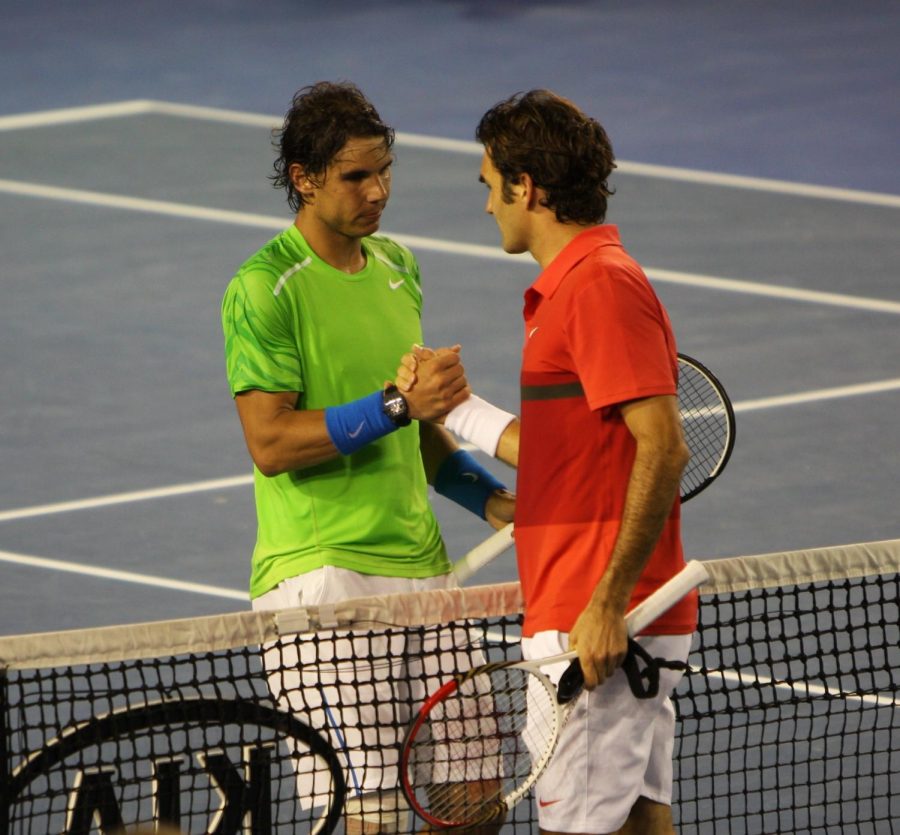The “G.O.A.T Debate” in Men’s Tennis can wait
Roger Federer and Rafael Nadal at the Australian Open in 2012.
June 25, 2018
World no. 1 Rafael Nadal recently reaffirmed his place as the greatest clay court player of all time. On June 9 in Paris, the Spaniard won an unprecedented 11th French Open singles title as he stunned viewers while delivering what tennis fans have come to expect. Nadal is the only tennis player in the history of the sport to have won 11 titles at one grand slam event.
Nadal’s sublime run to the title has reenergized the popular debate on whether he or Switzerland’s Roger Federer should be named the greatest men’s tennis player of all time. But as the two multiple grand slam champions are presently so evenly matched, we need to wait until the end of both their careers before we can unequivocally say who the G.O.A.T. really is.
Federer’s ardent followers argue his current grand slam total is all that’s needed to establish him as the greatest. He has won the most slam titles of any male player in history, having hoisted 20 slam trophies throughout his career.
“Fed fans” do have a point.
Winning a grand slam is the highest accomplishment a tennis player could ever hope to achieve. Most professional players will only ever dream of winning one of the coveted tournaments. That just makes Federer’s resume that much more astounding, and, ostensibly, the greatest. However, like it or not, Nadal’s impressive statistics cast some rather convincing doubts on that assertion.
Nadal has a considerable lead in head-to-head matches against Federer (23-15), owns the most Masters 1000 titles (the most prestigious tournaments behind grand slams) and has an Olympic gold medal in singles from the 2008 summer games in Beijing, something Federer has yet to achieve.
Federer may have more slam titles than Nadal, but that is arguably at least in part due to the fact that he is older than him. Federer (aged 36) has had three whole years over Nadal (aged 32) to build up his experience and title count, as he began his professional career in 1998. Nadal didn’t turn pro until 2001.
Nadal has also been hampered by several serious injuries throughout his career. Knee and wrist problems have forced him out of many tournaments over the years. His recurring knee injury even forced him to cut his 2012 season in half.
Just this past January Nadal was forced to retire from the Australian Open semi-finals against Marin Cilic with an upper right leg injury. Nadal was a finalist in last year’s tournament. Federer, in comparison, has had to deal with very little injuries throughout his career, with a back injury forcing him out of various tournaments in recent years.
Federer indubitably has some of the most awe-inspiring achievements in sports’ history. But that makes it all the more remarkable that Nadal has achieved enough to even be included in the greatest of all time conversation. Especially when one considers he is almost five years Federer’s junior.
Other sports with athletes whose credentials clearly stand out have the luxury of declaring a G.O.A.T. But tennis fans should acknowledge that for Federer and Nadal, the race is still being run, and the two are neck and neck heading into the final stretch.
At age 32, Federer had the exact amount of slams Nadal has now. By the time he turns 36, Nadal may very well equal or even surpass Federer’s current total. Of course, Federer could win more slams in the future as well. The point is, we don’t know how much more both will achieve.
If we were arguing who the greatest of right now is and using grand slam titles as our only marker, then we’d obviously have to give it to the Swiss maestro. However, determining the greatest of all time is a complicated undertaking and must require us to have all the facts. We simply won’t have that until both players retire.
Declaring a sport’s G.O.A.T should be done without a shadow of a doubt. Right now, Nadal’s shadow is looming over Federer’s pedestal, readying to make its final strike.
And then there’s Novak Djokovic.




















